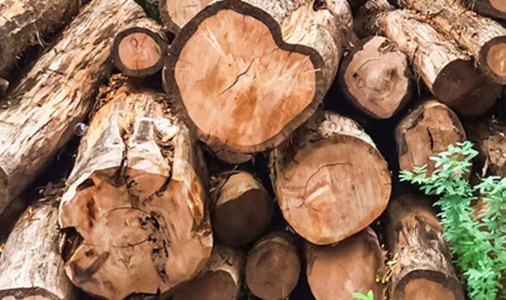Sheesham wood, also known as Indian Rosewood, is one of the most popular hardwoods used in furniture, carvings, flooring and decorative items. Known for its strength, durability and rich grain patterns, Sheesham is a favourite choice for Indian households and traditional carpentry. However, with the rise of cheap alternatives and look-alike woods, identifying original Sheesham wood has become important for buyers.
If you’re planning to invest in Sheesham furniture or raw wood, here’s a detailed guide on how to identify Sheesham wood.

1. Color and Appearance
Sheesham wood has a distinctive golden-brown to dark brown color with rich, natural grain patterns. The heartwood is usually darker, while the sapwood is lighter in shade. The grains often appear in straight or interlocked patterns, giving the wood a decorative look.
Fake or substitute woods may be painted or polished to mimic Sheesham, but their base color is often too uniform and lacks the natural depth found in real Sheesham.
2. Grain and Texture
One of the strongest identifiers of Sheesham is its grain pattern. It has well-defined, wavy, or straight grains that look natural and artistic. The texture is medium to coarse and gives a slightly rough feel if left unpolished.
Cheaper substitutes like mango wood or rubberwood have smoother, less visible grains, while engineered wood shows repetitive patterns that lack natural irregularities.
3. Weight and Density
Sheesham is a hardwood and therefore quite dense and heavy compared to softwoods. If you try to lift a piece of Sheesham furniture, it will feel substantially weightier than similar-sized items made of pine, teak substitutes, or plywood. Its weight is a sign of durability and long life.
4. Durability and Termite Resistance
Sheesham wood is known for its resistance to termites and decay, which makes it a popular choice for long-lasting furniture. If the wood looks weak, lightweight, or prone to small cracks and holes, it may not be original Sheesham. Authentic Sheesham feels sturdy and has a solid, dependable look.
5. Sound Test
A simple traditional test is the sound test. Tap lightly on the wood surface. Sheesham produces a deep, solid sound, while softwoods or engineered wood give a hollow or flat sound. This is a quick way to differentiate real hardwood from imitations.
6. Smell Test
Sheesham has a mild, pleasant, woody aroma that can be sensed when freshly cut or polished. Fake woods often lack this smell or may have a chemical-like odor due to artificial polishing.
7. Resistance to Water
Sheesham wood does not absorb water quickly, which helps protect it from moisture damage. If you drop a little water on an unpolished piece, the droplet will remain on the surface for some time before being absorbed. Fake or cheaper substitutes often soak up water instantly.
8. Price and Authenticity
Original Sheesham is relatively more expensive compared to mango wood, acacia, or rubberwood. If you find a piece of furniture being sold as “Sheesham” at a very cheap price, it’s likely not authentic. Always buy from trusted furniture showrooms or certified wood sellers who provide details about the wood type.
Conclusion
Identifying original Sheesham wood involves checking its color, grain pattern, weight, durability, and natural aroma. Genuine Sheesham is dense, strong, termite-resistant, and has unique grain designs that no synthetic or substitute wood can perfectly replicate.
When investing in Sheesham furniture, always purchase from reputed sellers and, if possible, ask for proof of wood type. Genuine Sheesham may cost more, but its durability and timeless beauty make it a worthy investment that can last for generations.